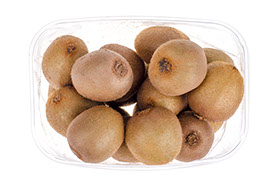
Overview
Compatibility & Temperature
Grade Tolerances
Nutrition Information
Kiwi Fruit
History
Kiwifruit jam from Lebanon
The fuzzy kiwifruit is native to southern China. It has now been declared a "National Fruit" of China. Other species of Actinidia are native to India and Japan and southeastern Siberia. Cultivation of the fuzzy kiwifruit spread from China in the early 20th century, when seeds were introduced to New Zealand by Mary Isabel Fraser, the principal of Wanganui Girls' College, who had been visiting mission schools in Yichang, China. The seeds were planted in 1906 by a Wanganui nurseryman, Alexander Allison, with the vines first fruiting in 1910.
Export markets opened up after World War II thanks to pioneering research into the transportability of the fruit by John Pilkington Hudson and others at the agriculture department in Wellington.
Sources: Wikipedia

Compatibility
USDA recommended storage 32° F. (0° C.)
Approximate freezing point 29.0° F. (-1.7° C.)Fruit should be forced air cooled within eight to twelve hours and held at recommended temperatures thereafter. Adequate air circulation and humidity of 90% to 95% are also essential during storage and shipping.
Temperature
Shipper recommendations vary. Ripe or ethylene treated melons are sometimes shipped or held for short periods at 36.5 to 41° F. Chilling damage may occur if held at these temperatures for extended periods. USDA recommends 45 to 50° F (7 to 10° C)
Sources: USDA, Produce Blue Book

Summary of Published Grade Standard Tolerances
(The following pertains to U.S. No. 1 unless otherwise noted.)
For defects
(All grades)
At shipping point
8% total including
4% serious including
1% decay or internal breakdown
For defects
(U.S. Fancy & U.S. No. 1)
At destination
(See F.O.B. GOOD DELIVERY GUIDELINES)
12% total including
8% permanent
6% serious including
4% serious permanent and
2% decay or internal breakdown
Size
Must be fairly uniform
Quality Defects
1) Maturity
2) Shape
3) Cleanness
4) Leaf Or Limb Rubs 5) Hail Injury
6) Growth Cracks 7) Scab
8) Scars
9) Scale
10) Old Insect Damage 11) Sun Scald
12) Drop Shoulder
13) Alligator Skin
14) Hayward Mark
Condition Defects
1) Firmness
2) Bruising
3) Discoloration
4) Sunken Or Pitted Areas
5) Freezing Or Freezing Injury 6) Surface Mold
7) Shriveling
8) Gray Mold Rot
9) Alternaria Rot
10) Phomopsis Stem End Rot
11) Blue Mold Rot
Suitable Shipping Condition/
F.O.B. Good Delivery Guidelines
(Maximum percentage for 5 day normal transit.)
15% total including
8% serious including
3% decay or internal breakdown
Nutrition Facts
Serving Size 1 fruit
Amount Per Serving
Calories from Fat 4Calories 46
% Daily Values*
Total Fat 0.4g 1%
Saturated Fat 0.022g 0%
Polyunsaturated Fat 0.218g
Monounsaturated Fat 0.036g
Cholesterol 0mg 0%
Sodium 2mg 0%
Potassium 237mg
Total Carbohydrate 11.14g 4%
Dietary Fiber 2.3g 9%
Sugars 6.83g
Protein 0.87g
Vitamin A 0% Vitamin C 118%
Calcium 3% Iron 1%
* Percent Daily Values are based on a 2000 calorie diet. Your daily values may be higher or lower depending on your calorie needs.
Nutrition Values are based on USDA Nutrient Database SR18

Century Farms International, Inc.
10957 NW 123rd Street Medley, FL 33178
Office: 305-436-7971 Fax: 305-436-7968




